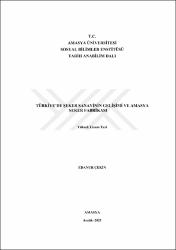Türkiye'de şeker sanayinin gelişimi ve Amasya Şeker Fabrikası

View/
xmlui.dri2xhtml.METS-1.0.item-rights
info:eu-repo/semantics/openAccessDate
2022Metadata
Show full item recordAbstract
Birinci Dünya Savaşı'nın uluslararası ticareti olumsuz etkilemesi sonucu Osmanlı Devleti'nde şeker kıtlığı meydana gelmiştir. Şeker kıtlığı Millî Mücadele döneminde de devam etmiş, halk şekere ulaşmada zorluk çekmiş ve şeker lüks tüketim maddesi olarak görülmüştür. Yeni Türk Devleti'nin kurulması ve onu takip eden süreçte ekonomik yatırımlara önem verilmiş, özellikle Cumhuriyet'in ilanından sonra ülkede şeker sanayi kurmak için yasalar hazırlanmıştır. Yapılan kanun çalışmaları sonuç vermiş, 1923-1939 yılları arasında 4 şeker fabrikası faaliyete başlamış, halkın bir nebze de olsa şeker ihtiyacı kurulan bu fabrikalar aracılığı ile karşılanmıştır. Türkiye'de şeker sanayinin genişlemesi 1950 yılında Demokrat Parti'nin iktidara gelmesi ile mümkün olmuştur. 1950-1960 yılları arasında on bir adet şeker fabrikası açılmış, iki şeker fabrikasının ise temeli atılmıştır. 2000 senesine gelindiğinde ise ülkede aktif halde çalışan şeker fabrikalarının sayısı 29'a yükselmiştir. Şeker fabrikalarının sayısının artması sadece şeker üretim miktarını arttırmakla kalmamış aynı zamanda tarım ve hayvancılıkta gelişmelere, Türk halkının yaşam biçiminde yeniliklere neden olmuştur. Çalışmamızın asıl konusu olan Amasya Şeker Fabrikası, DP'nin Şeker Sanayii'nin Tevsi Programı kapsamında kurulması planlanan ve 1954 yılında işletmeye açılan Türkiye'nin sekizinci şeker fabrikasıdır. Yoğun araştırmalar sonucu kaleme aldığımız çalışmamızın amacı, Amasya'nın Suluova ilçesinde kurulan şeker fabrikasının ilçeye ve bölgeye olan sosyo-ekonomik katkılarını ortaya çıkarmaktır. Çalışmamızda T.C. Devlet Arşivleri Başkanlığı Cumhuriyet Arşivi (BCA), T.C. Devlet Arşivleri Başkanlığı Osmanlı Arşivi (BOA), Amasya Şeker Fabrikası Özel Arşivi, Süreli Yayınlar ve akademik çalışmalardan yararlanılmıştır. As a result of the negative impact of World War First on international trade, sugar shortage occurred in the Ottoman Empire. The shortage of sugar continued during the National Struggle, the people had difficulty in reaching sugar and sugar was seen as a luxury consumer item. Economic investments were given importance in the establishment of the new Turkish State and in the following period, laws were prepared to establish a sugar industry in the country, especially after the proclamation of the Republic. The work of the law yielded results, 4 sugar factories started to operate between 1923-1939, and the sugar needs of the people were met through these established factories. The expansion of the sugar industry in Turkey became possible with the coming to power of the Democrat Party in 1950. Eleven sugar factories were opened between 1950-1960, and the foundations of two sugar factories were laid. By the year 2000, the number of sugar factories working actively in the country increased to 29. The increase in the number of sugar factories not only increased the amount of sugar production, but also led to developments in agriculture and animal husbandry, and innovations in the lifestyle of the Turkish people. Amasya Sugar Factory, which is the main subject of our study, is Turkey's eighth sugar factory, which was planned to be established within the scope of DP's Expansion Program of Sugar Industry and put into operation in 1954. The aim of our study, which we wrote as a result of intensive research, is to reveal the socio-economic contributions of the sugar factory established in the Suluova district of Amasya to the district and the region. In our study, T.C. Presidency of State Archives Republic Archive (BCA), T.C. Presidency of State Archives Ottoman Archive (BOA), Amasya Sugar Factory Special Archive, Periodicals and academic studies were used.
URI
https://tez.yok.gov.tr/UlusalTezMerkezi/TezGoster?key=RjZwH00oMG4iNa5Sgvlgg3thB9ec91Pl3oHR_h7MFTqLeAvOxbZ6iPdkFA4Z6z1Zhttps://hdl.handle.net/20.500.12450/1918
Collections
- Tez Koleksiyonu [318]

















